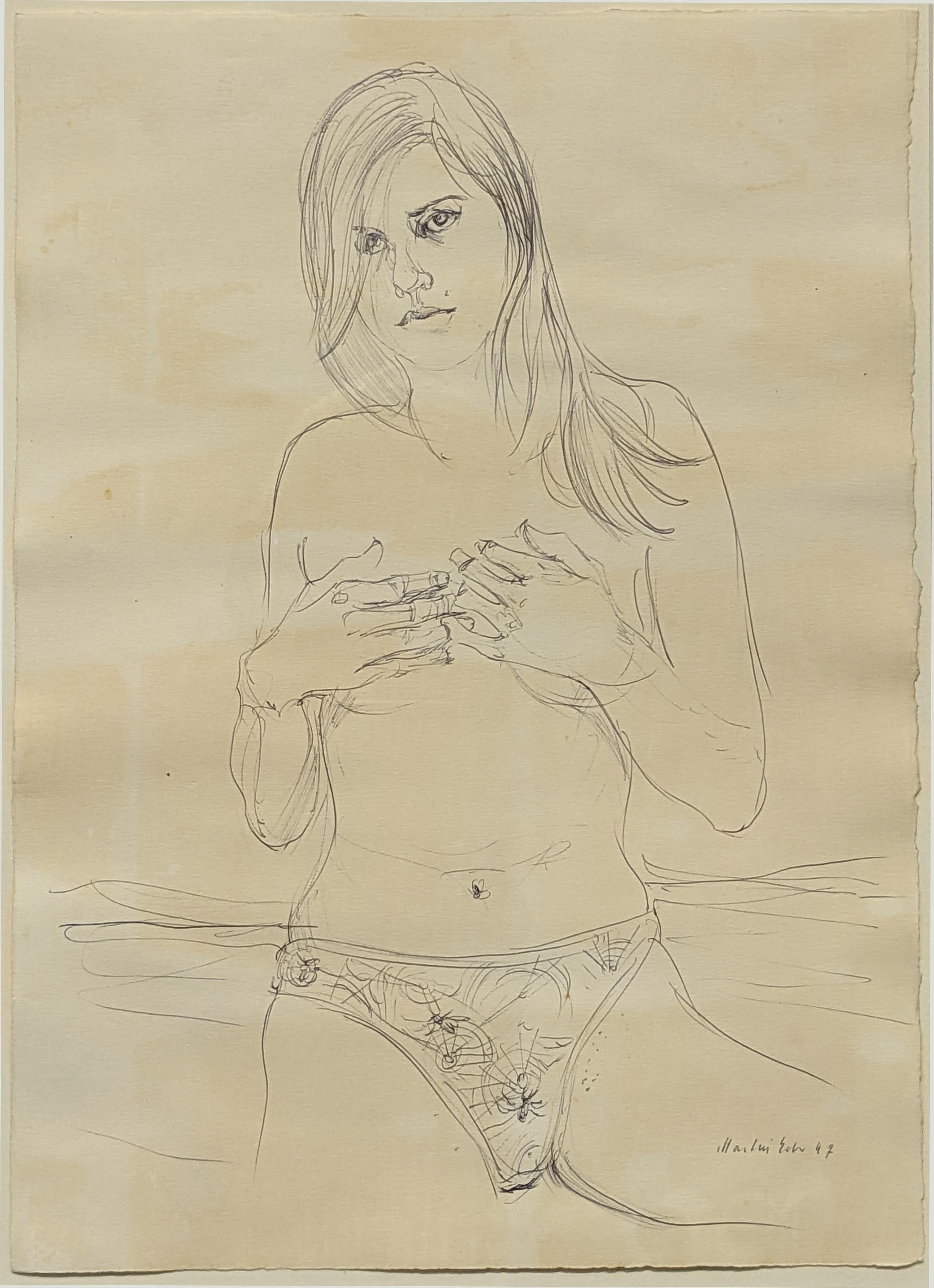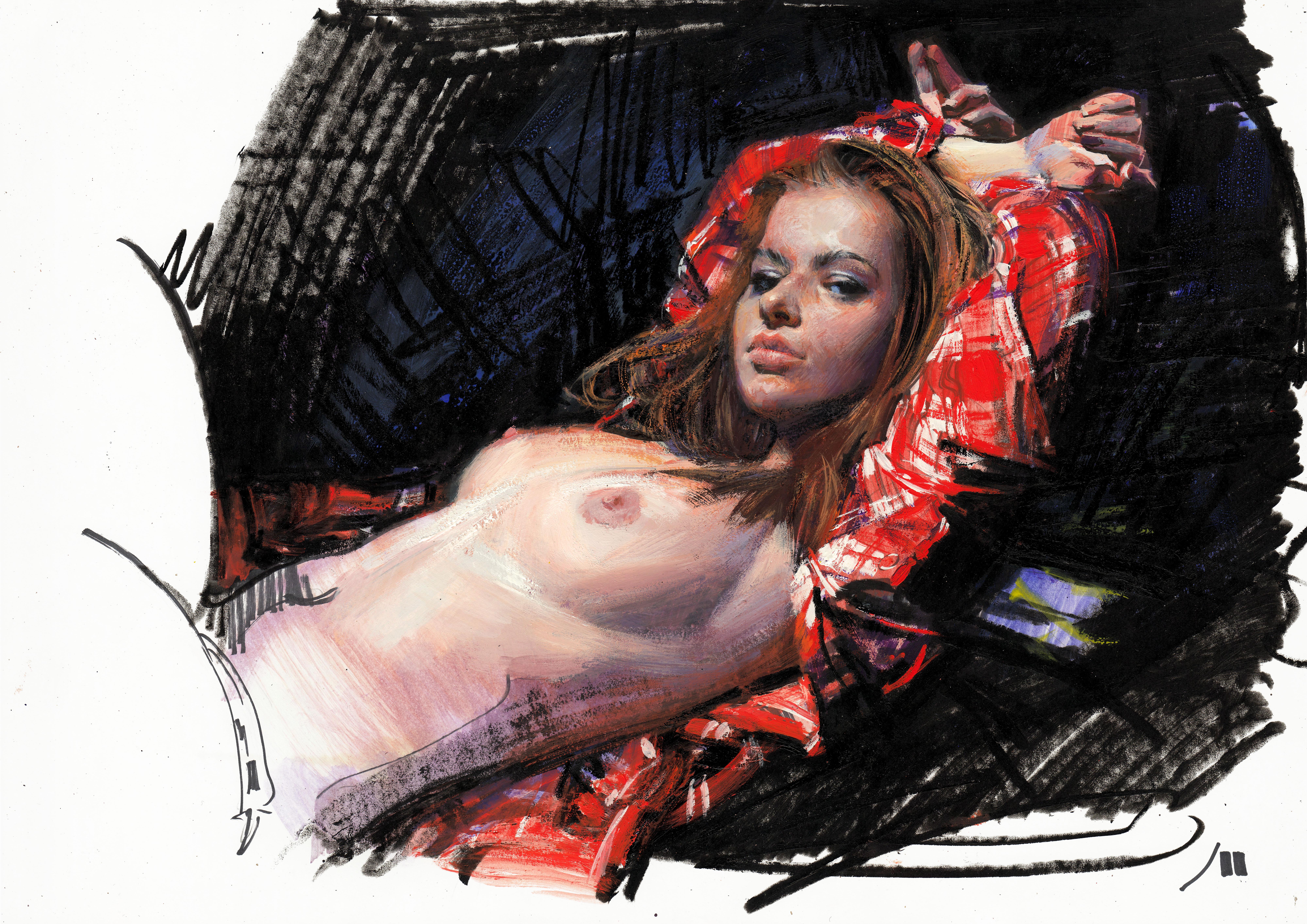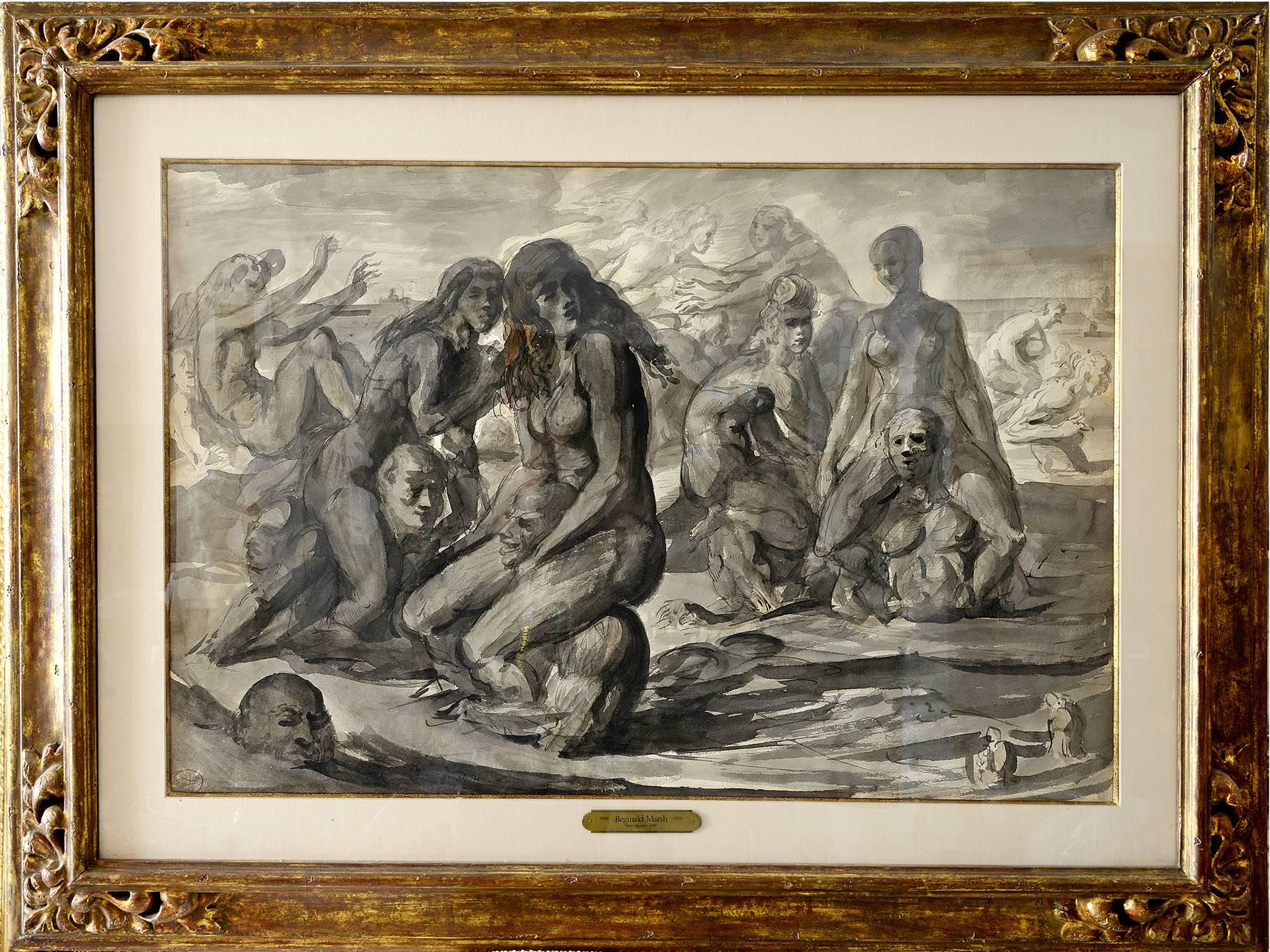Items Similar to "Boating on the Morin River"
Want more images or videos?
Request additional images or videos from the seller
1 of 8
André Dunoyer de Segonzac"Boating on the Morin River"1922-1924
1922-1924
About the Item
Pen, ink, watercolor and wash on paper by André Dunoyer de Segonzac, France, 1922-1924. Boating on the Morin River. Measurements : with frame: 52.5x65x2 cm - 20.7x25.6x0.8 inches / without frame: 36.5x45 cm - 14.4x17.7 inches. Signed lower left "A. Dunoyer de Segonzac". Colors may vary slightly depending on your screen. The lighter band at the top and the bottom of the piece, visible in the first picture, is only due to the reflection in the protective glass. It does not exist. In its frame gilt with gold leaf and its protective glass.
André Dunoyer de Segonzac was born in Boussy-Saint-Antoine (Essonne) July 7, 1884. After his schooling at high school Henri IV, as early as 1900, he attends classes at the National School of Fine Arts in Paris in free listener where he will befriend Charles Dufresne. In 1903, he enters the private studio of Luc-Olivier Merson. In 1907, he studies with Jean-Paul Laurens and attends the La Palette and Colarossi academies in Montparnasse. He meets Luc-Albert Moreau and Jean-Louis Boussingault with whom he shares a studio. His first drawings are published in 1908 in The Great Review and The Witness. Nearly indifferent to contemporary aesthetic revolutions, Dunoyer de Segonzac undertakes, with Jean-Louis Boussingault and Luc-Albert Moreau, to revive Gustave Courbet's realism by performing still lifes, nudes, landscapes, in a thick paste and masonry . In one of his letters to the painter Maurice Boitel, he wrote in the 1950s: "I have not forgotten the heroic period of the independents - when we were grouped around Paul Signac, the charming and valiant Maximilien Luce - in these barracks where the living and authentic Art was grouped outside the academic formulas - or literary and systematic tendencies - which were to lead to this abstract aesthetic of which the painting dies. "
In 1908, he begins exhibiting at the Salon d'Automne and the Salon des Indépendants, with Paul Signac and Maximilien Luce. He befriends Apollinaire, Max Jacob, Raoul Dufy and Vlaminck. From this period, renting a house belonging to Signac, Dunoyer discovers the landscapes of Saint-Tropez, to which he will remain faithful and where he lived until the end of his life. He stays in Saint-Tropez only in the summer season. For the rest, he leads a real nomadic life, in search of the motive especially through the Île-de-France, the Grand Morin valley, Feucherolles, Chennevières-sur-Marne, Guyancourt, etc. "I also worked a lot on the banks of the Seine in Chatou, Bougival, Andrésy, Poissy and Triel that I particularly like, with its beautiful Gothic church that is reflected in the Seine and the high wooded hills that surround him", he will say.
In 1910, he knows fashion designer Paul Poiret and meets Max Jacob, Raoul Dufy and Vlaminck. From 1910 to 1914, he travels to Italy, Spain, North Africa, and is interested in sport and dance (drawings of Isadora Duncan's Russian Ballets, 1911, The Boxers1910). From 1914 to 1918, mobilized in the infantry, he makes the war hardly, before being assigned to camouflage. He performs many war drawings, valuable for their artistic and documentary value.
From 1919, he appears again in many exhibitions, including major Parisian salons. Nearly indifferent to contemporary aesthetic revolutions, Dunoyer de Segonzac undertakes, with Boussingault and Moreau, to revive Courbet's realism by performing still lifes, nudes, landscapes, in a thick and masonry paste. Enlisted in engraving by Jean Émile Laboureur, he makes nearly 1,600 brass plaques from 1919 to 1970. He was president of the Society of French painters-engravers.
In 1921, he meets Paul Valéry, Léon-Paul Fargue and Jean Cocteau. In 1928, he makes a trip to America where he met with great success. In 1930, he becomes friend with Derain. In 1933 he receiveds the Carnegie Foundation of Pittsburgh Award and in 1934 the Venice Biennale.
During the Occupation, in November 1941, he takes part in a "study trip" to Germany, organized by Arno Breker, accepting, like other artists of the most renowned, to visit the hotspots of German culture as well as artist workshops.
After the war, he is exhibited in the best galleries, in 1949-1950 at the Galerie Charpentier, in 1969 at the Galerie Vallotton, and in 1972 the Galerie Durand-Ruel.
Dunoyer de Segonzac has made sets and costumes for the theater, illustrated many literary works (Carco, Dorgeles, Tristan Bernard, Paul Morand, Jules Romains, etc.). He has also published extensively, including his etchings. Realist artist, he is the heir of Le Nain, Courbet and Millet. An independent painter, he never adhered to any of the great aesthetic movements of the beginning of the century. His style reflects the need for a new chromatic sobriety and a great graphic rigor; his palette is limited to dark shades, "Spartan", dominated mainly by ochres, lands, dark reds.
Dunoyer de Segonzac is an excellent draftsman. His graphics are characterized by the extreme precision of the line and by a great conciseness of form: Isadora Duncan (1909). In 1912, he adopted the technique of the pen, which is better suited to the effectiveness of his line. Its main sources of inspiration are the landscapes of the Île-de-France and the Midi represented in winter, a season whose stripping is perfectly suited to the graphic conciseness and monochromatism of the artist.
Watercolor is for him a painting in itself. An initial drawing in ink governs the whole composition and dominates the color: Roquebrune (1946), series of the Massif des Maures (1938, 1939 and 1947). Only the oil painting betrays an influence of cubism in the exceptional will of organization of the composition. It should be noted, however, a party of geometry that tempers the sensation. He shows a strong preference for massive forms, for a compact matter, and gives more importance to values than colors: The Canoeists (1914), Landscape in Saint-Tropez (1927), Still life with bread and wine (1936).
He is as an engraver and illustrator that he gives free rein to his sensibility: "My conception of engraving is quite similar to the one I have in drawing. It is a spontaneous and direct reaction to life, landscape, movement, light. The etching has been for me a complement of the drawing, it is the sister. His prints are incisive, expressive: a continuation of The Valley of Morin (1923), Beaches (1935), Tableau de la boxe (1921). Among his works as an illustrator, include the Cross of Wood Dorgelès (1921) and The Georgics of Virgil (1944-1947). A retrospective of his work as a painter and draftsman was presented in Paris in 1972 at the Galerie Durand-Ruel.
André Dunoyer de Segonzac died in Paris in 1974. He rests in St Tropez.
Awards and Recognition
1933: Carnegie Foundation of Pittsburgh Foundation Award
1934: prize of the Venice Biennale
1947: Member of the Royal Academy of London
1948: Associate member of the Royal Academy of Belgium
Exhibitions (selection)
1920: special exhibition, London
1938: Chicago
1939: London, Wildenstein Gallery
1949-1950: Charpentier Gallery, Paris - Basel
1951: Geneva Museum of Art and History
1959: Royal Academy of London
1969: Vallotton Gallery, Lausanne
1972: Durand-Ruel Gallery, Paris
Museums
The works by Dunoyer de Segonzac are present in the most prestigious museums of the world. Note the National Museum of Modern Art (Paris) where more than 70 works are listed (including thirty drawings). Among his emblematic works, we find oils on canvas such as Two nudes (ooc 1911), Bacchus (ooc 1933), Grand nude lying (ooc 1921), Lunch on the grass (1913), The bathers (1923), Nude lying with a black shoe (1922), The young ladies of the Marne (1923), and many others, as well as very beautiful watercolors such as The Gulf of Saint-Tropez in winter (1938), etc ... But also the Museum of Modern Art of the city of Paris with Lying Nude (hst 1919), Characters (hst 1920), Plowing in Provence (watercolor 1935), etc ... But also the Museum of Modern Art of New York, .. .
- Creator:André Dunoyer de Segonzac (1884-1974, French)
- Creation Year:1922-1924
- Dimensions:Height: 20.67 in (52.5 cm)Width: 25.6 in (65 cm)Depth: 0.79 in (2 cm)
- Medium:
- Movement & Style:
- Period:
- Condition:
- Gallery Location:Saint Amans des cots, FR
- Reference Number:1stDibs: LU1088213431802
About the Seller
5.0
Vetted Seller
These experienced sellers undergo a comprehensive evaluation by our team of in-house experts.
1stDibs seller since 2018
34 sales on 1stDibs
- ShippingRetrieving quote...Ships From: Saint Amans des cots, France
- Return PolicyA return for this item may be initiated within 2 days of delivery.
More From This SellerView All
- Berthomme Saint-André, The Nap, Watercolor, 1925By Louis Berthomme Saint-AndreLocated in Saint Amans des cots, FRWatercolor by Louis BERTHOMME SAINT-ANDRE, France, ca.1925. The nap. With frame: 75x60.5 cm - 29.5x23.8 inches, without frame, just the watercolor: 53x39 cm - 20.9x15.35 inches. Signed lower left "Berthomme St André" (see photo). Louis Berthommé Saint-André is a figurative painter, fresco painter, decorator, illustrator, engraver, ceramist and French lithographer born in 1905. He comes from rural and commercial France: his father ran a wine and grocery business. In his youth, Louis Berthommé Saint-André was injured by a kick, which left him with a stiff leg, preventing him from driving, among other things. The family left Oise to settle in Saintes, where the artist studied at La Recouvrance. He entered as a student architect with Georges Naud, responsible for the historical monuments of Charente then, in 1921, he entered the School of Fine Arts in Paris. Louis Berthommé Saint-André is one of the great representatives of French figurative painting in the 20th century. He was trained at the School of Fine Arts by two very old masters who died during his training: Fernand Cormon (1845-1924) and Jean-Paul Laurens (1838-1921). He retains from their training the taste for well-learnt techniques, but from his first works, he is part of modernity. His constructions show decomposed forms inspired by Cézanne, while maintaining a keen sense of rigour. He never strayed from realism, but his very colourful, sometimes incisive palette and his freedom in representation gave his painting a bite and an acidity that placed Louis Berthommé Saint-André among the great talents of his time. Silver medal at the Salon of French Artists where he exhibited from 1924 to 1929, he won the Abd-el-Tif Prise in 1925 and was then the youngest resident of the villa in Algiers. Friend of Jean Launois, in addition to his recognised portraits, he painted Algiers and the Kasbah. His studies of women recall those of Eugène Delacroix, but if his luminous inspiration is due to the Algerian sun, his touch is more Cézanne than purely orientalist. He left Algeria in 1928, to return there in 1931. Before the war, Berthommé Saint-André exhibited regularly in all the major Salons: from 1928 at the Salon d'Automne, at the Salon des Beaux-Arts (1934 to 1936) at the Salon des Tuileries since 1935. His inspiration is close to surrealism . During the Occupation, he became very "fauve", in reaction to the darkness of the war. He joined the Resistance, and collaborated with Vaincre (Resistance newspaper). After the war, he developed a style close to poetic reality (Brianchon, Legueult, Oudot, Terechkovitch, Cavaillès. Caillard, Limouse, and Planson), without however ever being part of the group so called. He is present at the Salon Comparaison, at the Salon of painters Witnesses of our time, is president of the Salon of drawing and water-based painting. He has exhibited solo internationally, in Europe, the USA and Japan in particular. In 1977, he received just before his death, the grand prise of Painters Witnesses of their Time. He died on October 1, 1977 in Paris. Bibliography - Michel Droit. Berthommé Saint-André. Éditions de la revue moderne, 1981 Wall frescoes Entrance to the Direction, National School of Fine Arts, Paris Lycée Charlemagne, Paris, Notre-Dame and the banks of the Seine, 1952 Staircase of the Staff of Poitiers Personal exhibitions Villa Abd-el-Tif, Alger, 1922 Galerie Armand Drouant, Paris, 1928 Galerie Marcel Bernheim...Category
1920s Post-Impressionist Nude Drawings and Watercolors
MaterialsPaper, Watercolor
- Berthomme Saint-André, Before Bathing, 1926By Louis Berthomme Saint-AndreLocated in Saint Amans des cots, FRWatercolor by Louis BERTHOMME SAINT-ANDRE, France, 1926. Befor bathing. With frame: 74x63.5 cm - 29.1x25 inches ; without frame, just the watercolor: 50x36 cm - 19.7x14.2 inches. Si...Category
1920s Art Deco Nude Drawings and Watercolors
MaterialsWatercolor
- Henri Rapin, Gouache on Paper "Fructidor", 1924-1928Located in Saint Amans des cots, FRThis gouache is a museal and historical piece. Gouache and charcoal on paper stuck on panel by Henri Rapin, France, 1924-1928. "Fructidor". With frame: 80x114x3 cm - 31.5x44.9x1.2, w...Category
1920s Art Deco Figurative Drawings and Watercolors
MaterialsPaper, Gouache
- James Ward The Fisherman's FamilyBy James WardLocated in Saint Amans des cots, FRPrecious Watercolor attributed to James WARD (1769-1859) - England, 1830-1840. The Fisherman' S Family. Measurements : View : 20"x14.6" (51x37 cm), With frame : 26.6"x21.5" (67.5x54....Category
1830s Romantic Figurative Drawings and Watercolors
MaterialsPaper, Watercolor
- Madeleine RENAUD, Watercolor, The Wreath Of CarnationsLocated in Saint Amans des cots, FRWatercolor by Madeleine RENAUD (1900-1994), France. Wreath of Carnations. With frame: 60.2x89 cm - 23.7x35 inches without frame: 73x43 cm - 28.7x16.9 inches. Signed "Madeleine Renaud...Category
20th Century Impressionist Figurative Drawings and Watercolors
MaterialsWatercolor
- Deschmacker, Young Woman Lying By The Sea, WatercolorBy Paul Alex DeschmackerLocated in Saint Amans des cots, FRWatercolor by Paul-Alex Deschmacker, France, 1920s. This watercolor is in the classical period populated by mythological characters of Paul-Alex Deschmacker, itself becoming part of ...Category
1920s Art Deco Figurative Drawings and Watercolors
MaterialsWatercolor
You May Also Like
- untitled / ohne TitelBy Martin EderLocated in New York, NYMartin Eder untitled work on paper executed in ballpoint pen with traces of watercolor. Ohne Titel Arbeit auf Papier, ausgeführt in Kugelschreiber mit Spuren von Aquarell. 2007Category
Early 2000s Realist Nude Drawings and Watercolors
MaterialsInk, Watercolor, Pen
- Morning stretchesLocated in Sempach, LUA quick live sketch is always a little imperfect - too little time and too much adrenaline in the blood at this moment, but it perfectly conveys the delight of beauty and, as the Fre...Category
2010s Realist Nude Drawings and Watercolors
MaterialsPaper, Tempera, Permanent Marker
- KatyaLocated in Sempach, LUThis is one of those sketches where Evgeniy Monahov first used an industrial marker together with tempera - the thick velvety black of his lines expands the tonal range of the delica...Category
2010s Realist Nude Drawings and Watercolors
MaterialsPermanent Marker, Tempera, Paper
- Water Sports - Nude Swimmers and Bathers at Coney IslandBy Reginald MarshLocated in Miami, FLHistorically, academic artists have always featured the central figures in their composition in a prominent light with the background figures being darker. In water sports...Category
1940s Realist Figurative Drawings and Watercolors
MaterialsIndia Ink, Watercolor
- "The Dance, " Ludovico Lipparini, graphite, gouache, mythological, classicalLocated in Wiscasset, ME"The Dance" by Ludovico Lipparini is a beautifully rendered work on paper in the classical tradition using graphite and gouache and created in the f...Category
Early 19th Century Realist Figurative Drawings and Watercolors
MaterialsGraphite, Paper, Gouache
- Comme des Garcons, fashion show model Fall 2021By Manuel SantelicesLocated in Miami Beach, FLComme des Garcons Fall 21, by Manuel Santelices Ink pen and watercolor Overall size: 12 in H x 9 in W One of a Kind Unframed 2021 The worlds of fashion, society, and pop culture a...Category
21st Century and Contemporary Contemporary Figurative Drawings and Water...
MaterialsWatercolor, Ink, Pen





